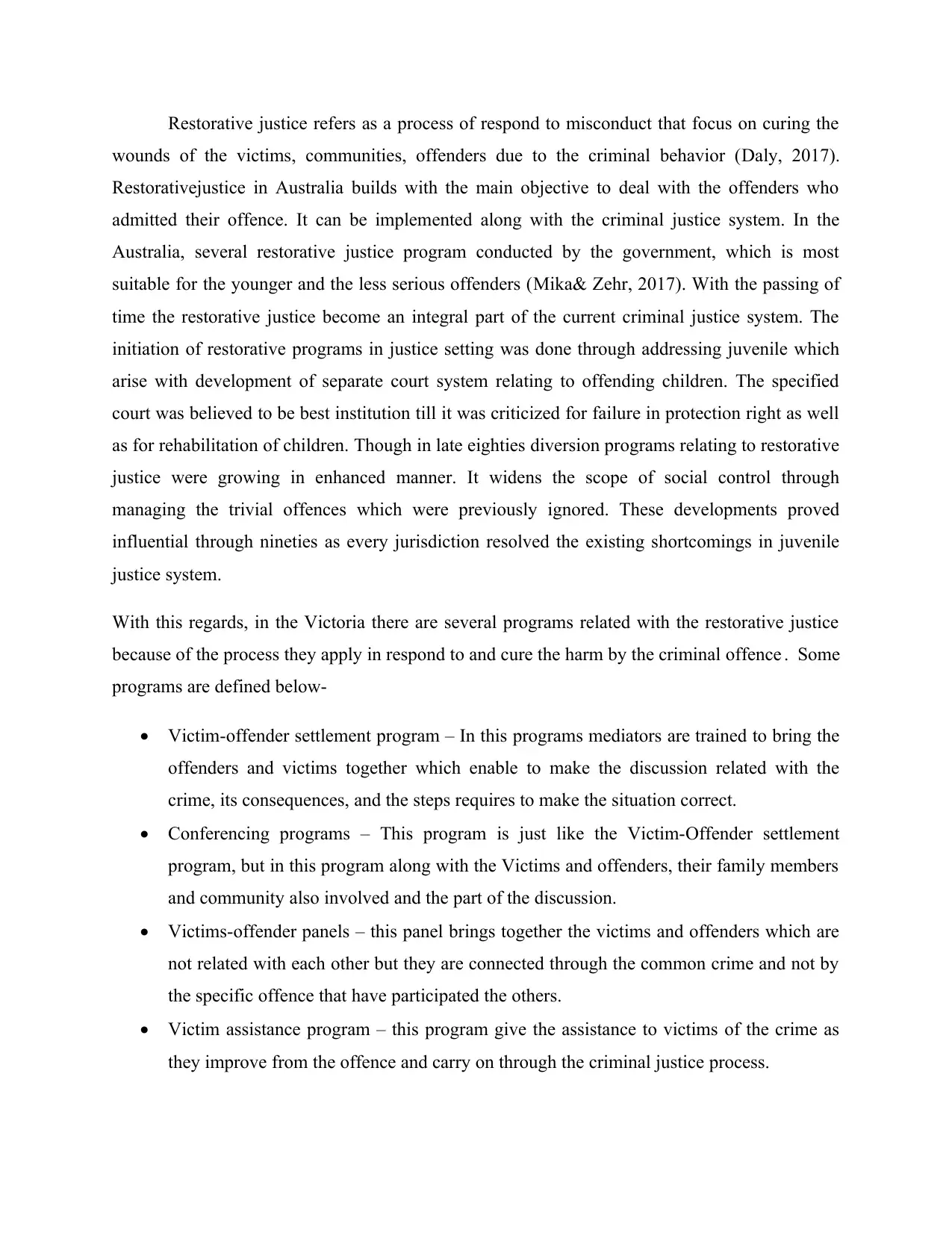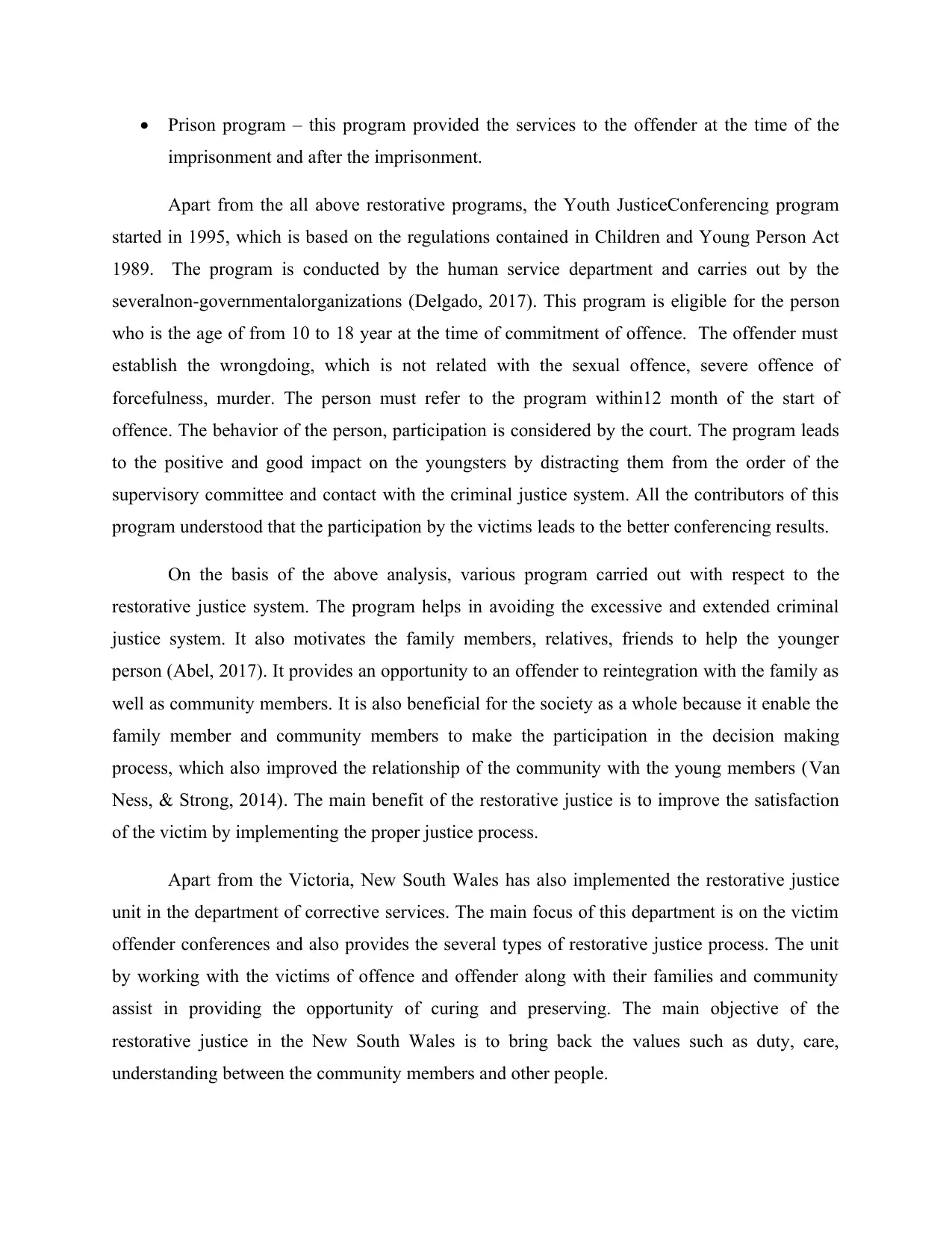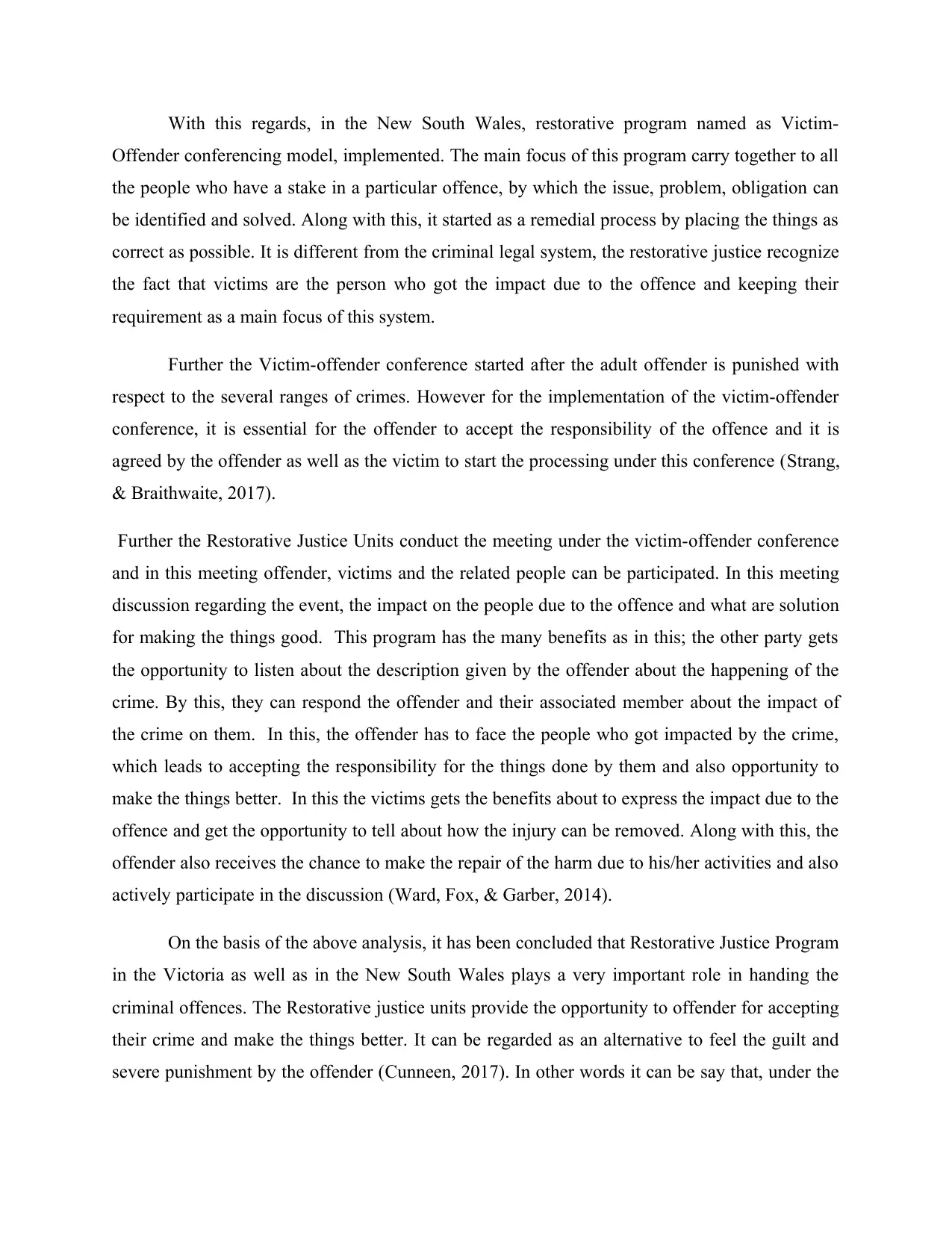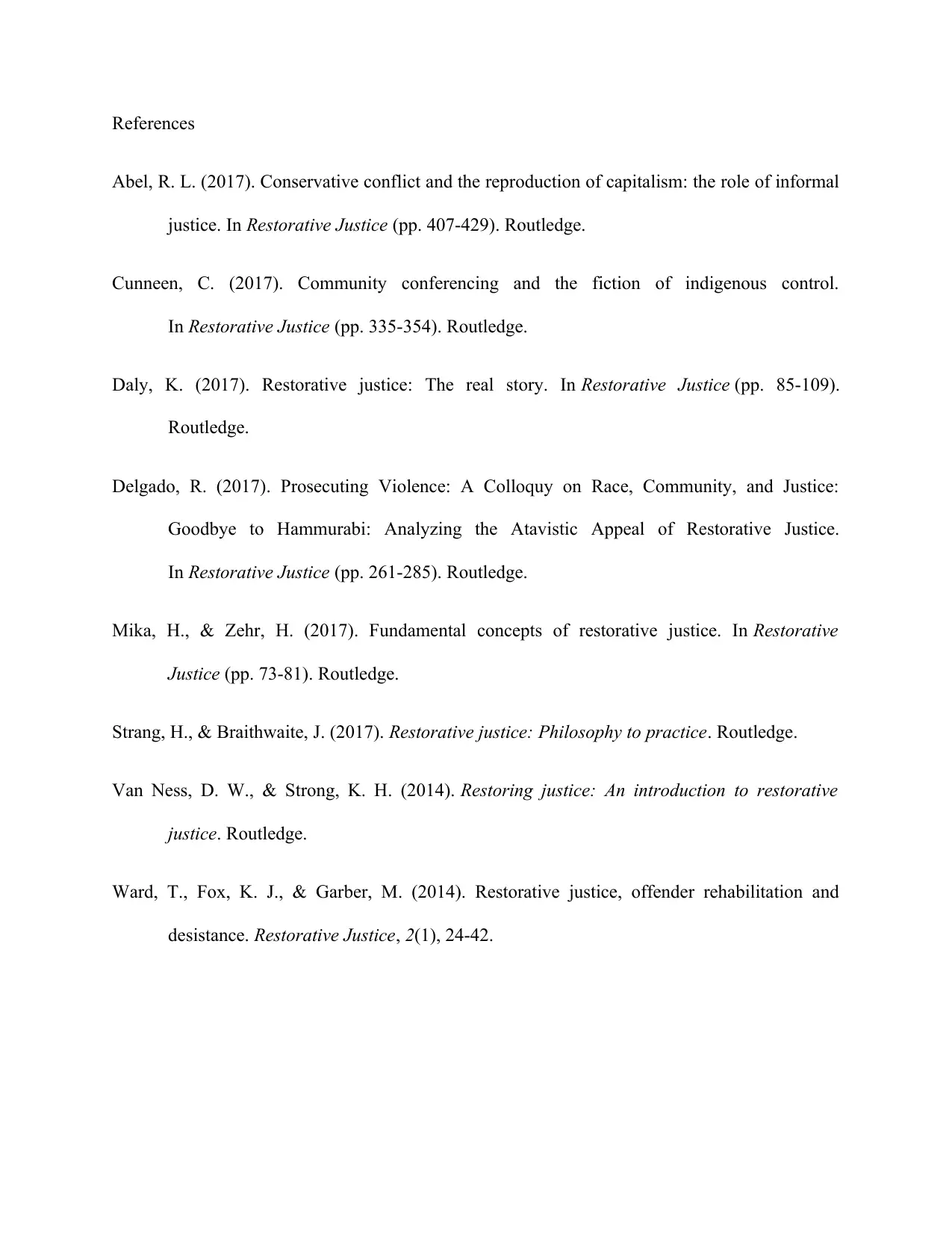Restorative Justice Approaches in Australia: An Analytical Essay
VerifiedAdded on 2023/05/28
|6
|1618
|67
Essay
AI Summary
This essay provides an analytical overview of restorative justice approaches in Australia, focusing on Victoria and New South Wales. It examines various restorative justice programs, including victim-offender settlement programs, conferencing programs, and victim assistance programs. The essay highlights the Youth Justice Conferencing program in Victoria and the Victim-Offender Conferencing model in New South Wales, discussing their objectives, implementation, and benefits. It emphasizes the role of restorative justice in addressing criminal offenses, promoting offender accountability, and facilitating victim healing and community reintegration. The analysis concludes that restorative justice offers a valuable alternative to traditional punishment, fostering fairness and encouraging responsibility among offenders.

Topics in criminology
Paraphrase This Document
Need a fresh take? Get an instant paraphrase of this document with our AI Paraphraser

Restorative justice refers as a process of respond to misconduct that focus on curing the
wounds of the victims, communities, offenders due to the criminal behavior (Daly, 2017).
Restorativejustice in Australia builds with the main objective to deal with the offenders who
admitted their offence. It can be implemented along with the criminal justice system. In the
Australia, several restorative justice program conducted by the government, which is most
suitable for the younger and the less serious offenders (Mika& Zehr, 2017). With the passing of
time the restorative justice become an integral part of the current criminal justice system. The
initiation of restorative programs in justice setting was done through addressing juvenile which
arise with development of separate court system relating to offending children. The specified
court was believed to be best institution till it was criticized for failure in protection right as well
as for rehabilitation of children. Though in late eighties diversion programs relating to restorative
justice were growing in enhanced manner. It widens the scope of social control through
managing the trivial offences which were previously ignored. These developments proved
influential through nineties as every jurisdiction resolved the existing shortcomings in juvenile
justice system.
With this regards, in the Victoria there are several programs related with the restorative justice
because of the process they apply in respond to and cure the harm by the criminal offence . Some
programs are defined below-
Victim-offender settlement program – In this programs mediators are trained to bring the
offenders and victims together which enable to make the discussion related with the
crime, its consequences, and the steps requires to make the situation correct.
Conferencing programs – This program is just like the Victim-Offender settlement
program, but in this program along with the Victims and offenders, their family members
and community also involved and the part of the discussion.
Victims-offender panels – this panel brings together the victims and offenders which are
not related with each other but they are connected through the common crime and not by
the specific offence that have participated the others.
Victim assistance program – this program give the assistance to victims of the crime as
they improve from the offence and carry on through the criminal justice process.
wounds of the victims, communities, offenders due to the criminal behavior (Daly, 2017).
Restorativejustice in Australia builds with the main objective to deal with the offenders who
admitted their offence. It can be implemented along with the criminal justice system. In the
Australia, several restorative justice program conducted by the government, which is most
suitable for the younger and the less serious offenders (Mika& Zehr, 2017). With the passing of
time the restorative justice become an integral part of the current criminal justice system. The
initiation of restorative programs in justice setting was done through addressing juvenile which
arise with development of separate court system relating to offending children. The specified
court was believed to be best institution till it was criticized for failure in protection right as well
as for rehabilitation of children. Though in late eighties diversion programs relating to restorative
justice were growing in enhanced manner. It widens the scope of social control through
managing the trivial offences which were previously ignored. These developments proved
influential through nineties as every jurisdiction resolved the existing shortcomings in juvenile
justice system.
With this regards, in the Victoria there are several programs related with the restorative justice
because of the process they apply in respond to and cure the harm by the criminal offence . Some
programs are defined below-
Victim-offender settlement program – In this programs mediators are trained to bring the
offenders and victims together which enable to make the discussion related with the
crime, its consequences, and the steps requires to make the situation correct.
Conferencing programs – This program is just like the Victim-Offender settlement
program, but in this program along with the Victims and offenders, their family members
and community also involved and the part of the discussion.
Victims-offender panels – this panel brings together the victims and offenders which are
not related with each other but they are connected through the common crime and not by
the specific offence that have participated the others.
Victim assistance program – this program give the assistance to victims of the crime as
they improve from the offence and carry on through the criminal justice process.

Prison program – this program provided the services to the offender at the time of the
imprisonment and after the imprisonment.
Apart from the all above restorative programs, the Youth JusticeConferencing program
started in 1995, which is based on the regulations contained in Children and Young Person Act
1989. The program is conducted by the human service department and carries out by the
severalnon-governmentalorganizations (Delgado, 2017). This program is eligible for the person
who is the age of from 10 to 18 year at the time of commitment of offence. The offender must
establish the wrongdoing, which is not related with the sexual offence, severe offence of
forcefulness, murder. The person must refer to the program within12 month of the start of
offence. The behavior of the person, participation is considered by the court. The program leads
to the positive and good impact on the youngsters by distracting them from the order of the
supervisory committee and contact with the criminal justice system. All the contributors of this
program understood that the participation by the victims leads to the better conferencing results.
On the basis of the above analysis, various program carried out with respect to the
restorative justice system. The program helps in avoiding the excessive and extended criminal
justice system. It also motivates the family members, relatives, friends to help the younger
person (Abel, 2017). It provides an opportunity to an offender to reintegration with the family as
well as community members. It is also beneficial for the society as a whole because it enable the
family member and community members to make the participation in the decision making
process, which also improved the relationship of the community with the young members (Van
Ness, & Strong, 2014). The main benefit of the restorative justice is to improve the satisfaction
of the victim by implementing the proper justice process.
Apart from the Victoria, New South Wales has also implemented the restorative justice
unit in the department of corrective services. The main focus of this department is on the victim
offender conferences and also provides the several types of restorative justice process. The unit
by working with the victims of offence and offender along with their families and community
assist in providing the opportunity of curing and preserving. The main objective of the
restorative justice in the New South Wales is to bring back the values such as duty, care,
understanding between the community members and other people.
imprisonment and after the imprisonment.
Apart from the all above restorative programs, the Youth JusticeConferencing program
started in 1995, which is based on the regulations contained in Children and Young Person Act
1989. The program is conducted by the human service department and carries out by the
severalnon-governmentalorganizations (Delgado, 2017). This program is eligible for the person
who is the age of from 10 to 18 year at the time of commitment of offence. The offender must
establish the wrongdoing, which is not related with the sexual offence, severe offence of
forcefulness, murder. The person must refer to the program within12 month of the start of
offence. The behavior of the person, participation is considered by the court. The program leads
to the positive and good impact on the youngsters by distracting them from the order of the
supervisory committee and contact with the criminal justice system. All the contributors of this
program understood that the participation by the victims leads to the better conferencing results.
On the basis of the above analysis, various program carried out with respect to the
restorative justice system. The program helps in avoiding the excessive and extended criminal
justice system. It also motivates the family members, relatives, friends to help the younger
person (Abel, 2017). It provides an opportunity to an offender to reintegration with the family as
well as community members. It is also beneficial for the society as a whole because it enable the
family member and community members to make the participation in the decision making
process, which also improved the relationship of the community with the young members (Van
Ness, & Strong, 2014). The main benefit of the restorative justice is to improve the satisfaction
of the victim by implementing the proper justice process.
Apart from the Victoria, New South Wales has also implemented the restorative justice
unit in the department of corrective services. The main focus of this department is on the victim
offender conferences and also provides the several types of restorative justice process. The unit
by working with the victims of offence and offender along with their families and community
assist in providing the opportunity of curing and preserving. The main objective of the
restorative justice in the New South Wales is to bring back the values such as duty, care,
understanding between the community members and other people.
⊘ This is a preview!⊘
Do you want full access?
Subscribe today to unlock all pages.

Trusted by 1+ million students worldwide

With this regards, in the New South Wales, restorative program named as Victim-
Offender conferencing model, implemented. The main focus of this program carry together to all
the people who have a stake in a particular offence, by which the issue, problem, obligation can
be identified and solved. Along with this, it started as a remedial process by placing the things as
correct as possible. It is different from the criminal legal system, the restorative justice recognize
the fact that victims are the person who got the impact due to the offence and keeping their
requirement as a main focus of this system.
Further the Victim-offender conference started after the adult offender is punished with
respect to the several ranges of crimes. However for the implementation of the victim-offender
conference, it is essential for the offender to accept the responsibility of the offence and it is
agreed by the offender as well as the victim to start the processing under this conference (Strang,
& Braithwaite, 2017).
Further the Restorative Justice Units conduct the meeting under the victim-offender conference
and in this meeting offender, victims and the related people can be participated. In this meeting
discussion regarding the event, the impact on the people due to the offence and what are solution
for making the things good. This program has the many benefits as in this; the other party gets
the opportunity to listen about the description given by the offender about the happening of the
crime. By this, they can respond the offender and their associated member about the impact of
the crime on them. In this, the offender has to face the people who got impacted by the crime,
which leads to accepting the responsibility for the things done by them and also opportunity to
make the things better. In this the victims gets the benefits about to express the impact due to the
offence and get the opportunity to tell about how the injury can be removed. Along with this, the
offender also receives the chance to make the repair of the harm due to his/her activities and also
actively participate in the discussion (Ward, Fox, & Garber, 2014).
On the basis of the above analysis, it has been concluded that Restorative Justice Program
in the Victoria as well as in the New South Wales plays a very important role in handing the
criminal offences. The Restorative justice units provide the opportunity to offender for accepting
their crime and make the things better. It can be regarded as an alternative to feel the guilt and
severe punishment by the offender (Cunneen, 2017). In other words it can be say that, under the
Offender conferencing model, implemented. The main focus of this program carry together to all
the people who have a stake in a particular offence, by which the issue, problem, obligation can
be identified and solved. Along with this, it started as a remedial process by placing the things as
correct as possible. It is different from the criminal legal system, the restorative justice recognize
the fact that victims are the person who got the impact due to the offence and keeping their
requirement as a main focus of this system.
Further the Victim-offender conference started after the adult offender is punished with
respect to the several ranges of crimes. However for the implementation of the victim-offender
conference, it is essential for the offender to accept the responsibility of the offence and it is
agreed by the offender as well as the victim to start the processing under this conference (Strang,
& Braithwaite, 2017).
Further the Restorative Justice Units conduct the meeting under the victim-offender conference
and in this meeting offender, victims and the related people can be participated. In this meeting
discussion regarding the event, the impact on the people due to the offence and what are solution
for making the things good. This program has the many benefits as in this; the other party gets
the opportunity to listen about the description given by the offender about the happening of the
crime. By this, they can respond the offender and their associated member about the impact of
the crime on them. In this, the offender has to face the people who got impacted by the crime,
which leads to accepting the responsibility for the things done by them and also opportunity to
make the things better. In this the victims gets the benefits about to express the impact due to the
offence and get the opportunity to tell about how the injury can be removed. Along with this, the
offender also receives the chance to make the repair of the harm due to his/her activities and also
actively participate in the discussion (Ward, Fox, & Garber, 2014).
On the basis of the above analysis, it has been concluded that Restorative Justice Program
in the Victoria as well as in the New South Wales plays a very important role in handing the
criminal offences. The Restorative justice units provide the opportunity to offender for accepting
their crime and make the things better. It can be regarded as an alternative to feel the guilt and
severe punishment by the offender (Cunneen, 2017). In other words it can be say that, under the
Paraphrase This Document
Need a fresh take? Get an instant paraphrase of this document with our AI Paraphraser

restorative justice system, fairness can be achieved by the accepting the responsibility of the
crime by the offender and taking the steps for curing the offence.
crime by the offender and taking the steps for curing the offence.

References
Abel, R. L. (2017). Conservative conflict and the reproduction of capitalism: the role of informal
justice. In Restorative Justice (pp. 407-429). Routledge.
Cunneen, C. (2017). Community conferencing and the fiction of indigenous control.
In Restorative Justice (pp. 335-354). Routledge.
Daly, K. (2017). Restorative justice: The real story. In Restorative Justice (pp. 85-109).
Routledge.
Delgado, R. (2017). Prosecuting Violence: A Colloquy on Race, Community, and Justice:
Goodbye to Hammurabi: Analyzing the Atavistic Appeal of Restorative Justice.
In Restorative Justice (pp. 261-285). Routledge.
Mika, H., & Zehr, H. (2017). Fundamental concepts of restorative justice. In Restorative
Justice (pp. 73-81). Routledge.
Strang, H., & Braithwaite, J. (2017). Restorative justice: Philosophy to practice. Routledge.
Van Ness, D. W., & Strong, K. H. (2014). Restoring justice: An introduction to restorative
justice. Routledge.
Ward, T., Fox, K. J., & Garber, M. (2014). Restorative justice, offender rehabilitation and
desistance. Restorative Justice, 2(1), 24-42.
Abel, R. L. (2017). Conservative conflict and the reproduction of capitalism: the role of informal
justice. In Restorative Justice (pp. 407-429). Routledge.
Cunneen, C. (2017). Community conferencing and the fiction of indigenous control.
In Restorative Justice (pp. 335-354). Routledge.
Daly, K. (2017). Restorative justice: The real story. In Restorative Justice (pp. 85-109).
Routledge.
Delgado, R. (2017). Prosecuting Violence: A Colloquy on Race, Community, and Justice:
Goodbye to Hammurabi: Analyzing the Atavistic Appeal of Restorative Justice.
In Restorative Justice (pp. 261-285). Routledge.
Mika, H., & Zehr, H. (2017). Fundamental concepts of restorative justice. In Restorative
Justice (pp. 73-81). Routledge.
Strang, H., & Braithwaite, J. (2017). Restorative justice: Philosophy to practice. Routledge.
Van Ness, D. W., & Strong, K. H. (2014). Restoring justice: An introduction to restorative
justice. Routledge.
Ward, T., Fox, K. J., & Garber, M. (2014). Restorative justice, offender rehabilitation and
desistance. Restorative Justice, 2(1), 24-42.
⊘ This is a preview!⊘
Do you want full access?
Subscribe today to unlock all pages.

Trusted by 1+ million students worldwide
1 out of 6
Related Documents
Your All-in-One AI-Powered Toolkit for Academic Success.
+13062052269
info@desklib.com
Available 24*7 on WhatsApp / Email
![[object Object]](/_next/static/media/star-bottom.7253800d.svg)
Unlock your academic potential
Copyright © 2020–2025 A2Z Services. All Rights Reserved. Developed and managed by ZUCOL.





